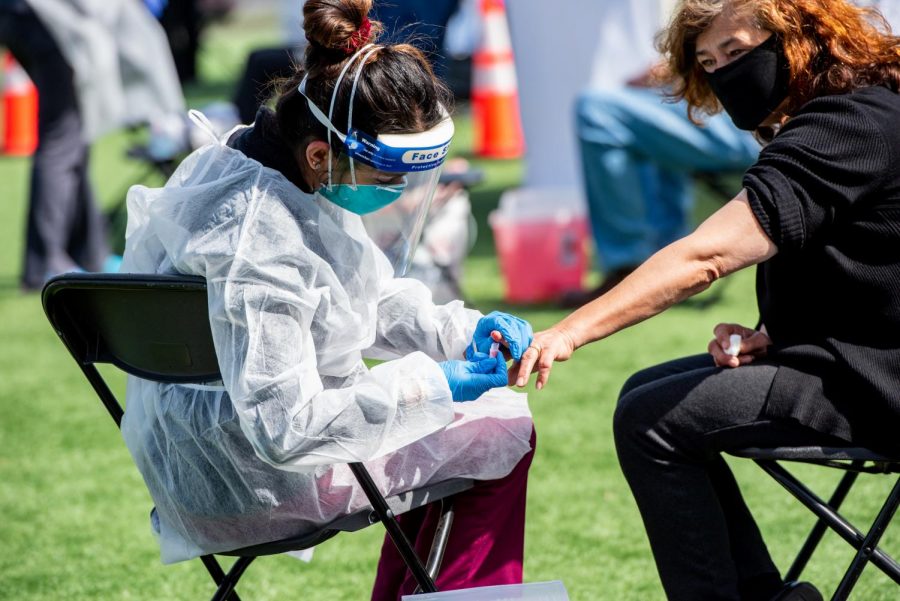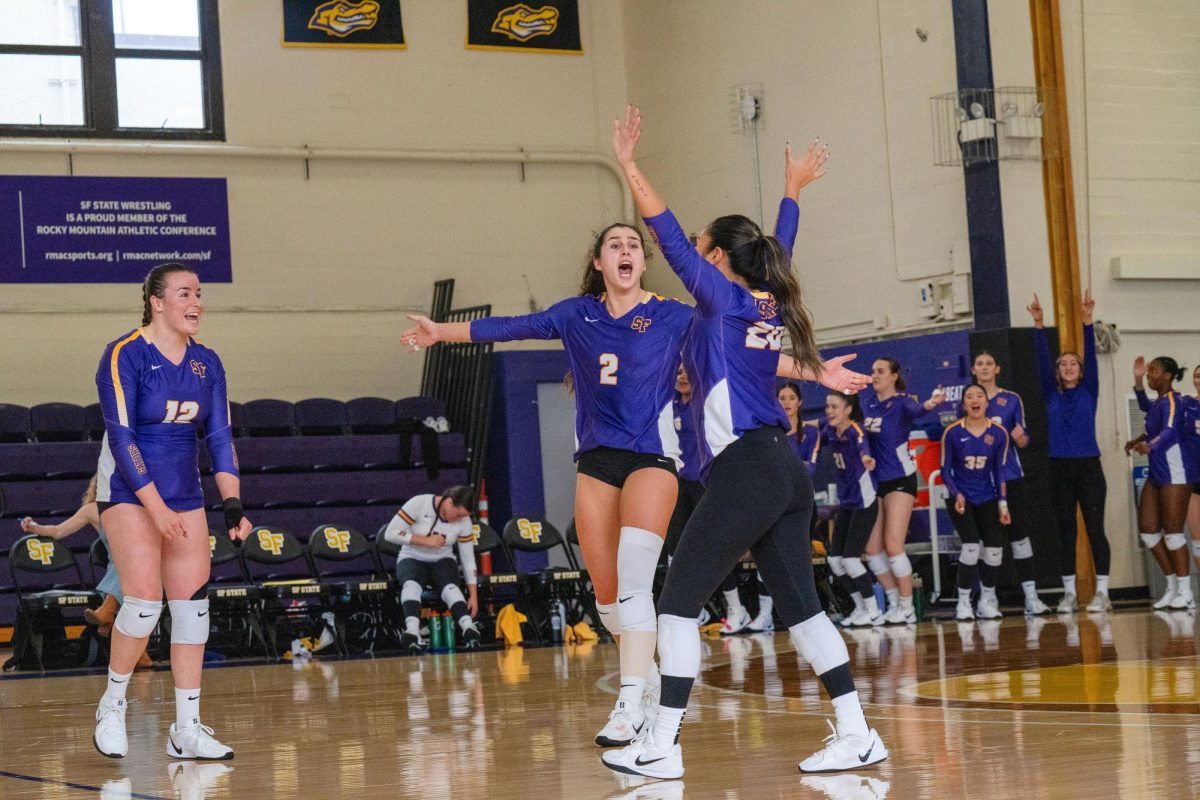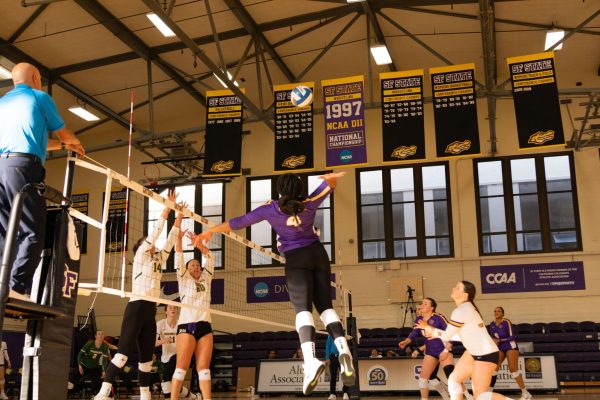Latino community affected by lack of translated information about coronavirus
36 percent of the reported cases of COVID-19 are inside the Latino community in San Francisco.
May 11, 2020
This story is translated in Spanish below.
The Latino population is one of the most affected by the COVID-19 pandemic and the cause could be rooted in the lack of accessible information.
Latino people represent 15% of San Francisco’s population but account for 36% of the reported cases of COVID-19 according to data according to data from the health department accessed on May 5. The disproportion between these two percentages is not particular to San Francisco. Data by a Kaiser Family Foundation report shows that Hispanic people in the U.S. made up a greater number of cases compared to their percentage in the total population. States such as Iowa and Wisconsin show the most disproportionate data, with 17% vs. 6% and 12% vs. 7% respectively.
Given the lack of resources, the difficulties of sheltering in place, and the few bilingual people working in the government and news media, Spanish COVID-19 information can be especially hard to access.
“The lack of information is going to result in the widening of the health disparities,” said Cathy Samayoa, adjunct assistant professor at SF State. “If the information isn’t available or it is not available in Spanish and in a way they [Spanish speakers] understand, there are not going to be able to do the things that are essential for their own survival.”
Samayoa researches in the Health Disparities Research Lab where she focuses on the disparities of breast cancer in Latino and African American communities.
The health disparities in the Latino community have not been exclusive to this pandemic, the Latino population is heavily affected by Type 2 Diabetes. According to the U.S. Department of Health and Human Services’ Office of Minority Health, some of the factors of Hispanic health are language/cultural barriers and the lack of access to preventive care.
Since these health disparities can be caused by disinformation, journalists around Northern California are analyzing the importance of Spanish coverage of COVID-19. El Tecolote, a bilingual newspaper is a well-known local newspaper that serves the Latino community in San Francisco.
“I made it a point that the story that the first story we were going to do had to be reported and written and published first in Spanish,” said Alexis Terrazas, the editor in chief of El Tecolote. “Because I felt like if we were this news media that’s going to be doing news on our community, it has to be accessible to our community.”
The widely-seen television stations, Univision and Telemundo, are at the forefront of providing information in Spanish for the Latino communities in the country.
“This coverage is the most important for me,” said Maria Antonieta Mejia, a Univision reporter. “I find that there is a lot of interest from the people to have information in their language. Many of the people we cover does not speak English.”
The number of Spanish language media outlets in San Francisco is still not enough to inform the more than 120,000 Latino residents in the city. And, while the Spanish-speaking population does rely heavily on television networks to get their news, according to PEW research, the number of Latinos who get their news online is increasing from 37% in 2006 to 74% in 2017.
“There used to be a number of Spanish language outlets in the Bay Area, now they no longer exist,” said Madeleine Blair, founder of El Timpano, a non-profit organization that looks to improve coverage of Latino immigrants in Oakland. “And while there is still a handful, they don’t have the resources to do the daily reporting or finding and translating and putting out information on a pandemic like this.”
Now, online platforms such as KQED and Mission Local have stepped up to create content in Spanish. Mission Local has been translating content and created a text message system in Spanish. KQED has started to translate their COVID-19 content in Spanish as well as send out a newsletter in Spanish to their subscribers.
“I think in newsrooms, in areas where it’s heavily Latino populated, it really should be the norm to have bilingual reporting,”said Azucena Rasilla, a former editor at the East Bay Express and now freelance journalist.
At the national level, there are few options for news outlets providing timely information in Spanish. One of them is Radio Bilingüe, a bilingual radio station serving around half a million listeners. Radio Bilingue produces the only Spanish-language national news talk-show and it is based in Fresno, California.
“We saw the necessity, especially for us in the Spanish media, in order to avoid a disproportionate number of infections in our communities,” said Samuel Orozco, the National Director of News at Radio Bilingüe. “That is what made us take the decision to not only focus on COVID-19 coverage but to raise the number and quantity of programs and announcements on air. We did it with the purpose to demystify and give timely information.”
But in communities where the government and news outlets fail to reach to the community, non- profit organizations serve as an informational bridge to overlooked communities.
“Nonprofits [organizations] have been the best resource because of the language barrier,” said Jacqueline Ocuña, who works as an executive team leader at Target. Ocuña and her family have relied on alternatives since her parents only consume news in Spanish.
Organizations such as Calle 24 Latino Cultural District and The Latina Center have been actively sharing information with their followers through social media. But sometimes, it takes a lot of effort to share information accurately.
“Even if we do have the information in English, there will be a delay in getting in Spanish for us to push out to the community,” said Marcy Flores, Program Consultant at Corazon Healdsburg at a non-profit organization in Sonoma county. “Which makes more work for us to translate documents and making sure the Spanish community gets it in their language.”
The consequences of the lack of timely information in Spanish are quickly being shown by the high number of cases of COVID-19 in the Latino communities.
“Whether it’s a delay in getting the information or not getting it at all can be the difference between life and death for some people,” Flores said.
La falta de información efectiva en Español afecta el número de casos de COVID-19 en la comunidad Latina
36 por ciento de los casos confirmados de COVID-19 forman parte de la comunidad Latina en San Francisco.
La comunidad Latina es una de las más afectadas por la pandemia del COVID-19 y la causa puede estar basada en la falta de información accesible.
La comunidad Latina representa el 15% de la población pero el 36% de los casos confirmados de COVID-19 en San Francisco, de acuerdo con información por el departamento de salud accedida el 5 de mayo. La disparidad que se presenta entre estos dos porcentajes no es solamente en San Francisco. De acuerdo con la Fundación Kaiser Family, la comunidad Hispana presenta un mayor número de casos comparado con su porcentaje en la población total. Los estados de Iowa y Wisconsin presentan datos altamente desiguales, con 17% versus 6% y 12% versus 7% respectivamente.
Dado a la falta de recursos, las dificultades de quedarse en casa y el poco personal bilingüe en el gobierno y en los medios de comunicación, información oportuna sobre el COVID-19 en español es difícil de obtener.
“La falta de información va a tener como resultado el incremento de desigualdades en la salud,” mencionó Cathy Samayoa, profesora en SF State. “Si la información no está disponible o no está disponible en español o en la manera que los hispanohablantes entiendan entonces esas personas no van a poder actuar de manera correcta para su propia sobrevivencia.”
Samayoa investiga en el laboratorio de Disparidades en la Salud en SF State en donde se enfoca en la disparidad de cáncer de mama en las comunidades Latinas y Afroamericanas.
Las desigualdades en la salud en las comunidades Latinas no son exclusivas durante esta pandemia, la población Latina es profundamente afectada por Diabetes Tipo 2. De acuerdo con la Oficina de Salud de las Minorías perteneciente al Departamento de Salud y Servicios Humanos, algunos de los factores que afectan la salud de los Hispanos son la barrera del idioma y la falta de acceso al cuidado preventivo tal como el seguro de vida.
Dado que la falta de información puede causar disparidades en la salud, periodistas alrededor del Norte de California están analizando la importancia de la cobertura del COVID-19 en español. El periodico bilingüe El Tecolote, es conocido por cubrir e informar a la comunidad Latina en San Francisco.
“Tomé la decisión de que la primera historia que publicaríamos iba a ser reportada, escrita y publicada en español,” mencionó Alexis Terrazas, editor en jefe de El Tecolote. “Si somos un periódico que informa a la comunidad Latina, nuestras noticias tienen que ser accesibles para ella.”
La televisoras populares, Univision y Telemundo, se encuentran al frente de la lucha por mantener informadas a las comunidades hispanohablantes en los Estados Unidos.
“Esta cobertura, para mí, es la cobertura más importante,” mencionó Maria A. Mejia, reportera de Univision en el Área de la Bahía. “Porque encuentro que hay muchísimo interés de la gente de tener información en su idioma, porque hay mucha gente a la que informamos que no habla inglés.”
El número de medios de comunicación en español en San Francisco no es suficiente para informar a los más de 120,000 residentes Latinos en la ciudad. Y, aunque la población hispano hablante se informa mayormente mediante la televisión, de acuerdo con investigación de PEW, el número de Latinos que obtienen sus noticias por medio del internet ha aumentado de un 37% en el 2006 a un 74% en el 2017.
“Solía haber un buen número de medios de comunicación en español en el Área de la Bahía que ahora no existen,” comentó Madeleine Blair, fundadora de El Tímpano, una organización sin fines de lucro que busca mejorar la cobertura de inmigrantes Latinos en Oakland. “Sigue habiendo algunos medios, pero estos no tienen los recursos suficientes para hacer reportajes diarios o encontrar, traducir y publicar información en una pandemia como esta.”
Actualmente, medios de comunicación en línea tal como KQED o Mission Local han empezado a crear contenido en español. Mission local ha traducido su contenido y creado un sistema de mensajes de texto los cuales informan noticias en español. KQED comenzó a traducir su contenido de COVID-19 al español y a enviar un boletín por correo electrónico en español a sus suscriptores.
“Yo pienso que debería ser una norma tener reportaje bilingüe en los medios que se encuentran en áreas con un gran número de población Latina,” mencionó Azucena Rasilla, ex editora del East Bay Express y periodista freelancer.
A nivel nacional, existen varias opciones de medios de noticias que proveen información oportuna en español y uno de los pocos es Radio Bilingüe. Esta estación está localizada primordialmente en Fresno, California, pero mantiene una audiencia de medio millón de personas alrededor del país. Radio Bilingüe produce el único programa de noticias y entrevistas en español.
“Nosotros vimos la necesidad, especialmente para nosotros en los medios en español, con el fin de evitar que hubiera un descontrolado brote de infecciones en nuestras comunidades,” comentó Samuel Orozco, el Director Nacional de Noticias de Radio Bilingüe. “Esto fue lo que nos obligó a no solo enfocarnos como nota titular en este tipo de temas noticiosos, si no a aumentar el número de programas y la cantidad de programas y de anuncios al aire relativos a este asunto con el ánimo de desmitificar algunas cosas y [hacer] llegar información oportuna.”
Sin embargo, las organizaciones sin fines de lucro sirven como un puente informativo para aquellas comunidades en las cuales, tanto el gobierno como los medios de noticias, han fallado en proporcionar información necesaria.
“Las organizaciones sin fines de lucro han sido el mayor recurso para mi familia debido a que proveen la información en español,” comentó Jacqueline Ocuña, quien trabaja en Target como líder ejecutiva. Ocuña y su familia se han apoyado en estas alternativas debido a que sus padres solamente consumen noticias en español.
Organizaciones como Calle 24 Latino Cultural District y The Latina Center han continuado activos en mantener a sus seguidores informados por medio de las redes sociales. Pero en ocasiones, el compartir información verdadera y oportuna toma un gran esfuerzo.
“Aún cuando tenemos la información en inglés, hay un retraso para hacerla llegar en español,” comentó Marcy Flores, Consultora de Programa de Corazón Healdsburg, una organización sin fines de lucro en el condado de Sonoma. “Esto genera más trabajo para nosotros debido a que necesitamos traducir los documentos y asegurarnos que le llegue la información a la comunidad Hispanohablante.”
Las consecuencias de la falta de información oportuna en español han surgido rápidamente debido al alto número de casos de COVID-19 en las comunidades Latinas.
“Ya sea un retraso en obtener la información o no tenerla en absoluto puede ser la diferencia entre la vida y la muerte para muchas personas,” comentó Flores.










